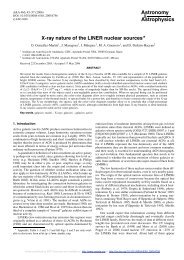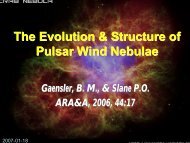Chandra X-Ray Observatory
Chandra X-Ray Observatory
Chandra X-Ray Observatory
You also want an ePaper? Increase the reach of your titles
YUMPU automatically turns print PDFs into web optimized ePapers that Google loves.
---For Seminar of ‘Touch Astronomy’<br />
Topic: <strong>Chandra</strong>-related X-ray<br />
Astronomy<br />
By Bing Jiang<br />
Introduction<br />
History of Space Observatories<br />
<strong>Chandra</strong> and products<br />
Data Analysis<br />
12/25/2004
Father of the X-<strong>Ray</strong><br />
Father of the X-<strong>Ray</strong><br />
• Wilhelm Conrad Roentgen<br />
was the first to discover the<br />
X-<strong>Ray</strong>. He first noted on<br />
their existence on<br />
November 8, 1895. He<br />
noticed that while he was<br />
working in his laboratory an<br />
object on the other side of<br />
the room began to glow.<br />
• 1901, the first Nobel Prize in<br />
Physics.<br />
2
Parts in the Spectrum<br />
Parts in the Spectrum<br />
• All parts of the electromagnetic spectrum are essentially<br />
the same thing: electromagnetic radiation. The only<br />
differences between them all are the frequency and<br />
wavelengths of the different types of waves.<br />
• X-<strong>Ray</strong>s are just one<br />
portion of the<br />
electromagnetic spectrum.<br />
Their wavelengths are<br />
larger than those of<br />
gamma rays, but smaller<br />
then the wavelengths of<br />
all other portions of the<br />
electromagnetic spectrum.<br />
3
A New Frontier<br />
A New Frontier<br />
• Perhaps the most<br />
important aspect of the<br />
X-<strong>Ray</strong> is its use in the<br />
field of medicine.<br />
• The first X-<strong>Ray</strong> photo of the<br />
human body was taken of the<br />
hand of a corpse by Wilhelm<br />
Roentgen himself in his<br />
laboratory in Vienna.<br />
4
A Second Frontier<br />
A Second Frontier<br />
• The X-<strong>Ray</strong> has also<br />
become a very useful<br />
tool in the field of<br />
astronomy.<br />
• The first imaging X-<strong>Ray</strong><br />
telescope was made under the<br />
direction of Riccardo Giacconi<br />
by American Science and<br />
Engineering in Cambridge, MA.<br />
It was flown on a small sounding<br />
rocket in 1965 and made crude<br />
images of hot spots in the upper<br />
atmosphere of the Sun.<br />
5
X-ray sources<br />
X-ray sources<br />
• Accretion surrounding the compact sources<br />
• Binary, BH<br />
• Solar X-ray emission<br />
• X-ray pulsar<br />
• X-ray emission in GRB<br />
• X-ray burst<br />
• SNR, radio pulsar<br />
• Galaxy<br />
• Cluster<br />
• AGN<br />
• ……<br />
6
Observal difficulty on X-ary<br />
Observal difficulty on X-ary<br />
• X-<strong>Ray</strong>s are mostly<br />
blocked out of the<br />
atmosphere.<br />
• Because of this,<br />
X-<strong>Ray</strong> observatories,<br />
like the <strong>Chandra</strong>,<br />
have to be placed<br />
far into space to<br />
collect accurate data.<br />
This means the<br />
ultra-precise mirrors<br />
and detectors.<br />
7
Telescopes<br />
• The first imaging X-<strong>Ray</strong><br />
telescope was made under<br />
the direction of Riccardo<br />
Giacconi by American<br />
Science and Engineering<br />
in Cambridge, MA. It was<br />
flown on a small sounding<br />
rocket in 1965 and made<br />
crude images of hot spots<br />
in the upper atmosphere of<br />
the Sun.<br />
8
Telescopes<br />
X-ray telescopes have a different design from optical<br />
telescopes.<br />
Because X-rays will reflect off mirrors only if they strike them<br />
at grazing angles.<br />
The mirrors have to be precisely shaped and aligned nearly<br />
parallel to incoming X-rays. Thus they look more like barrels<br />
than the familiar dish shape of optical telescopes.<br />
9
Early Space X-ray Observatories<br />
Early Space X-ray Observatories<br />
• Uhuru (1970.10-1973.3) [2-20 keV] NASA<br />
• Ariel-V (1973.10-1980.3) [0.3-40 keV] British-USA collaboration<br />
• HEAO-1 (1977.8-1979.1) [0.2keV-10MeV] NASA<br />
• Einstein(HEAO-2) (1978 11-1981 4) [0.2-20 keV] NASA<br />
10
Early Space X-ray Observatories<br />
Early Space X-ray Observatories<br />
• ROSAT (1990 1-1999 2) [0.1-2.5 keV] Germany/US/UK<br />
• ASCA (1993.2-2001.3) [0.4-10 keV] Japan/USA<br />
• BeppoSAX (1996.4-2002.4) [0.1-300 keV] Italian/Netherland<br />
11
Active Space X-ray Observatories<br />
Active Space X-ray Observatories<br />
• <strong>Chandra</strong> (1999.7-present)<br />
• XMM-Newton (1999.10-present)<br />
12
<strong>Chandra</strong>
<strong>Chandra</strong> X-<strong>Ray</strong> <strong>Observatory</strong><br />
<strong>Chandra</strong> X-<strong>Ray</strong> <strong>Observatory</strong><br />
• The most important X-<br />
<strong>Ray</strong> astronomy mission of<br />
the current decade is<br />
NASA’s <strong>Chandra</strong> X-<strong>Ray</strong><br />
<strong>Observatory</strong>, which was<br />
launched on July 23, 1999.<br />
It contains four sets off<br />
nested mirrors.<br />
• The third of NASA's<br />
Great Observatories for<br />
Space Astrophysics<br />
Schematic of Grazing Incidence, X-<strong>Ray</strong> Mirror<br />
15
<strong>Chandra</strong> X-<strong>Ray</strong> <strong>Observatory</strong><br />
<strong>Chandra</strong> X-<strong>Ray</strong> <strong>Observatory</strong><br />
16
<strong>Chandra</strong> X-<strong>Ray</strong> <strong>Observatory</strong><br />
<strong>Chandra</strong> X-<strong>Ray</strong> <strong>Observatory</strong><br />
• The <strong>Chandra</strong> X-<strong>Ray</strong><br />
<strong>Observatory</strong> has opened an<br />
important door for the field of<br />
astronomy. The mirrors on the<br />
<strong>Chandra</strong> have been polished to<br />
a smoothness of a few atoms.<br />
The mirrors are so strong that<br />
they can see twice as far and<br />
with five times greater detail<br />
than any other X-<strong>Ray</strong> telescope.<br />
High-resolusion X-ray telescope ~
SNR-Crab<br />
20
SNR-Cas A<br />
SNR-Cas A<br />
21
X-<strong>Ray</strong> Emissions<br />
X-<strong>Ray</strong> Emissions<br />
• This composite was taken by<br />
the <strong>Chandra</strong> <strong>Observatory</strong>.<br />
When they looked at this radio<br />
arc (in red), they observed an xray-emitting<br />
cloud about 40<br />
light-years wide (blue). These<br />
x-ray-emissions are caused<br />
when electrons from radio<br />
filaments collide with a cloud<br />
of cold gas with a mass millions<br />
of times greater than our sun’s.<br />
22
X-ray view of the Milky Way<br />
center<br />
• This is a mosaic of 30<br />
<strong>Chandra</strong> images. The<br />
Milky Way is home to<br />
more than a thousand<br />
white dwarfs, neutron<br />
stars and black holes.<br />
If you possessed x-ray<br />
vision, you would be<br />
able to see this image<br />
instead of the massive<br />
cosmic dust clouds.<br />
23
Black Holes<br />
Black Holes<br />
• Here is a composite of the<br />
black hole XTE J118+480<br />
taken by the <strong>Chandra</strong><br />
<strong>Observatory</strong>. It is seven<br />
times more massive than<br />
our sun, and takes material<br />
from an orbiting solartype<br />
star, and uses that<br />
material to create bursts of<br />
x-rays. Its x-ray spectrum<br />
is shown from the upper<br />
left corner to the lower<br />
right.<br />
24
Jovian X-ray and Ultraviolet<br />
Emissions<br />
Here is a composite<br />
image of Jupiter taken<br />
by the <strong>Chandra</strong><br />
<strong>Observatory</strong>. The xray<br />
pulses are shown<br />
in pink, and the blue<br />
features are ultraviolet<br />
aurorae.<br />
25
Jupiter’s Great X-ray Spot<br />
Jupiter’s Great X-ray Spot<br />
• The X-ray spots shown on<br />
the poles of Jupiter are<br />
just as surprising to<br />
astronomers today as the<br />
Great Red Spot once was.<br />
The false-color image is<br />
shown on the right and<br />
Jupiter’s x-ray emissions<br />
can be seen on the left,<br />
taken by the <strong>Chandra</strong><br />
<strong>Observatory</strong>.<br />
26
Venus in X-ray<br />
Venus in X-ray<br />
• The picture shown on the<br />
left is the first ever photo<br />
taken of Venus in the xray<br />
spectrum. The<br />
traditional optical view of<br />
Venus is shown on the<br />
right, and can be seen<br />
through a telescope.<br />
Venus’ x-rays are<br />
produced by fluorescence<br />
rather than reflection.<br />
Incoming solar x-rays<br />
excite atoms in Venus’<br />
atmosphere,<br />
and these atoms emit a<br />
fluorescence x-ray, creating the<br />
glowing effect seen on the left.<br />
27
Bibliography<br />
• http://chandra.harvard.edu/about/top_ten.ht<br />
ml<br />
• http://cxc.harvard.edu/<br />
• http://www.spacetoday.org/DeepSpace/Tele<br />
scopes/GreatObservatories/<strong>Chandra</strong>/Chandr<br />
aHistory.html<br />
• Google!<br />
28
Data Processing<br />
Data Processing<br />
Data Analysis :<br />
1. Data + Software<br />
2. Calibration<br />
3. Imaging Analysis<br />
Spectrum Analysis<br />
29
June,20,2003<br />
§2. Data Processing<br />
Data Processing Tools<br />
CIAO<br />
-- <strong>Chandra</strong> Interactive Analysis<br />
XSPEC<br />
of Observations (version 2.3)<br />
-- a software for spectral analysis<br />
Hello!<br />
Jiang Bing<br />
Astronomy department, NJU gingericejb@sohu.com30
• CIAO<br />
Data Processing<br />
Data Processing<br />
• <strong>Chandra</strong> Interactive<br />
Analysis of<br />
Observations<br />
• Radiation damage<br />
• Quantum Efficiency<br />
Losses<br />
• Bad column<br />
• Bad pixel<br />
• Cosmic ray afterglow<br />
• Standard pixel<br />
randomization<br />
• Potential background<br />
events<br />
31
June,20,2003<br />
§2. Data Processing<br />
Standard Data Processing (SDP)<br />
Level 0<br />
Level 1<br />
Level 2<br />
Level 3<br />
raw data<br />
start<br />
Jiang Bing<br />
Astronomy department, NJU gingericejb@sohu.com32
June,20,2003<br />
Level 1 product<br />
Data preparation<br />
Level 2 product<br />
Image Spectrum<br />
§2. Data Processing<br />
bad pixel<br />
Apply an ACIS Gain Map<br />
Apply the ACIS CTI Correction<br />
Remove Pixel Randomization<br />
Clean Defining ACIS Source Background & Background<br />
GRADE Regions and STATUS filtering<br />
Apply Three Extracting The Energy Good Extended Band Time Source Intervals Spectra (GTIs)<br />
Remove Identify and Responses and the ACIS Remove Readout Point Streak Sources<br />
Aspect Smoothing Apply the ACISABS<br />
offset and correction Exposure model Correction to an ARF<br />
Filtering Create Group a the<br />
Light RGB-Color output spectra<br />
CurveImage<br />
Analyze and Fit spectra with XSPEC<br />
Jiang Bing<br />
Astronomy department, NJU gingericejb@sohu.com33
Data Processing<br />
Data Processing<br />
Spectral fitting:<br />
Data + model + parameters<br />
With the tools, it is very easy.<br />
34
Time variability<br />
Time variability<br />
37
http://chandra.harvard.edu/cards/holiday.html<br />
Thanks for listening!<br />
38
Thanks for listening!<br />
39
















